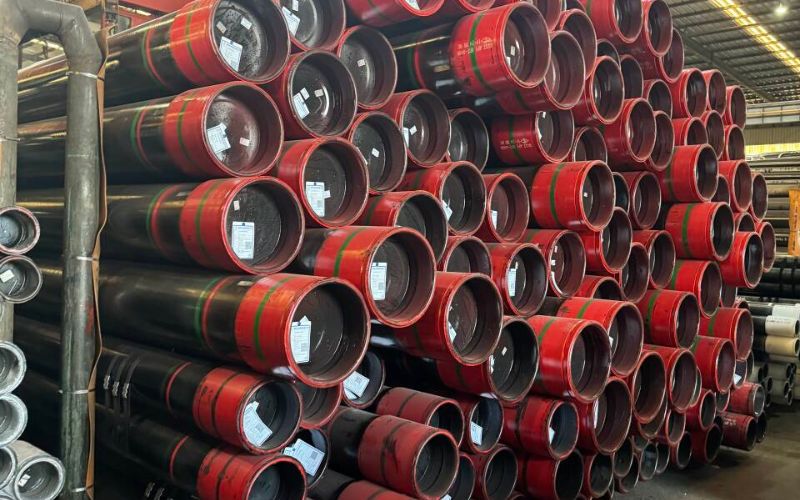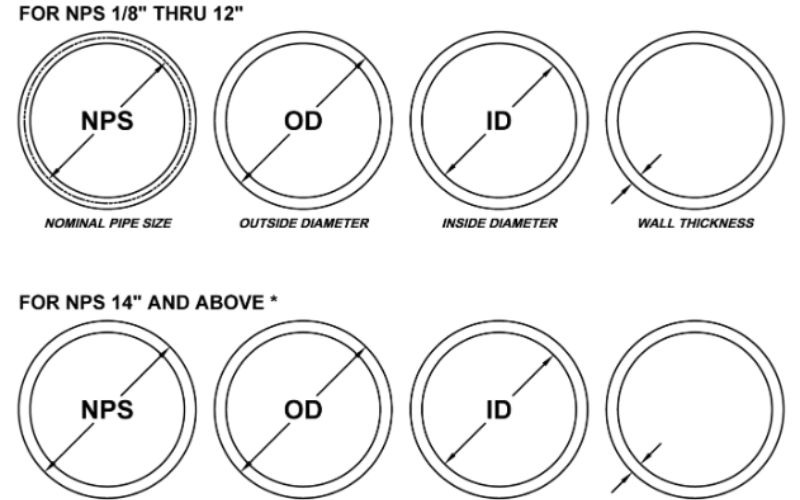The understanding of any specification governing design and function in piping systems is very essential. Schedule charts are helpful resources here, supplying detailed information about thickness, strength, and suitability of various pipes for a certain service. But, what do these charts mean, and how can they assist you in selecting the right materials for specification requirements? This article digs deep into the intricacies of pipe schedule charts, highlighting their importance and explaining the reading and practical application of these charts. Whether you are professional personnel or a DIY enthusiast or simply curious, this article will certainly help you make an informed decision.
Introduction to Pipe Schedules
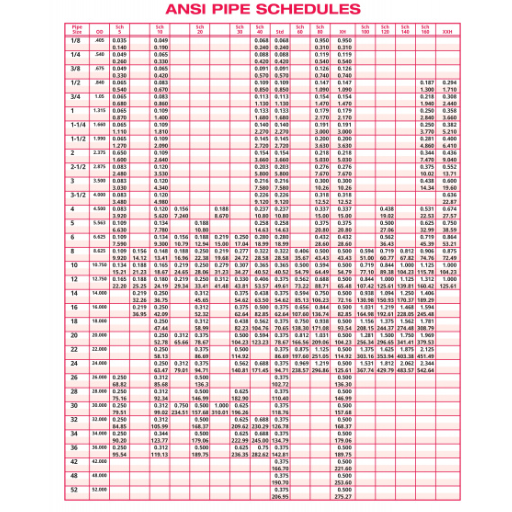
Pipe schedules are an observable means used to quote a pipe’s wall thickness. They chart out the relationship with pipe diameter, wall thickness, and pressure capacity; thus, it is required to meet safety and efficiency in all fields of application. The higher the schedule number, the thicker the walls and the greater the pipe’s ability to resist internal pressure. Some common schedule numbers include Schedule 40 for nominal wall thickness and Schedule 80 for extra wall thickness and are the most widely used across industries. By choosing the correct pipe schedule, you are able to select materials that are appropriate for the pressure and operational requirements of your undertaking.
What is a Pipe Schedule?
A pipe schedule is a standardized system that defines pipe wall thickness for a given nominal pipe size (NPS). The schedule will affect two main factors: the pipe’s ability to withstand an internal pressure and its ability to withstand an external stress. Pipe schedules were introduced by the American Society of Mechanical Engineers (ASME) to provide uniformity across industries.
Common schedules include Schedule 10, Schedule 40, Schedule 80, and Schedule 160. For example, Schedule 40 thins out to versatile and fairly strong use, while Schedule 80 stands for somewhat heavy-duty pipes. It goes like this: Schedule 40 pipes are used wherever moderate pressure and strength are enough, like plumbing and construction, and Schedule 80 pipes with thicker walls are used for high-pressure systems such as industrial piping or chemical processing units.
Importance of Pipe Schedule in Construction
The pipe schedule is important for the arm safe, durable, and efficient construction and engineering projects. A pipe schedule determines the wall thickness, which directly affects its pressure-rating ability. Higher pressure schedules such as the Schedule 80 or Schedule 160 can bear far greater pressures compared with low-pressure schedules such as Schedules 10 or 40. For instance, a 1-inch NPS pipe of Schedule 40 steel has a working pressure limited to approximately 990 psi, while the same size of Schedule 80 pipe can withstand pressures up to about 1,820 psi. This difference makes critical to the appropriate schedule selection in the instance of pressures exerted by fluids or gases in varying magnitudes.
Moreover, pipe schedules affect material cost, installation, and long-term maintenance. Higher pipe schedules are much heavier and require more material, thus increasing their cost and installation complexity. In contrast, a smaller pipe schedule would be less costly, easier to install, but would lack the strength for application under stress. To illustrate, Schedule 40 pipes are generally used in water distribution due to their being cost-effective and reliable under moderate pressure, while Schedule 80 or 160 may be used in chemical plants for superiority in strength against corrosive materials and leakages.
The knowledge of pipe schedule is equally necessary in the implementation of the industry standards, insisting safety ordinances, and sustainability ordinances. Accuracy in the selection of pipe schedules ensures safety of the structures operating under designed conditions today; it further avoids any possibility of failures or excessive wearing within time, thereby illustrating the need for detail planning while selecting pipes towards a given application.
Overview of ANSI and ASME Standards
Standards of the ANSI (American National Standards Institute) and ASME (American Society of Mechanical Engineers) serve as a backbone guarantee for consistency, quality, and safety across engineering and industrial matters. ANSI acts as a coordinator for voluntary activities of standardization in the U.S., thus lending credibility and uniformity to standards employed in systems, products, and processes. On the other hand, ASME is concerned with the development of engineering codes and standards, especially for mechanical systems like boilers, piping, and pressure vessels.
For example, ASME B31.3 is the most widely known process piping standard for the design, materials, fabrication, testing, and inspection for which services imparted ensure safely to pressure and temperature under which the piping systems can operate. The ASME BPVC (Boiler and Pressure Vessel Code) establishes safety requirements aimed at minimizing risks of mechanical failure under high pressures.
The ANSI grant accreditation to these groups, such as ASME, to ensure that the procedures they follow meet globally accepted standards, as ANSI is not a standard-developing group by itself. Standards such as ANSI/ASME Y14.5 for geometric dimensioning and tolerancing have become vital in modern manufacturing for precision design and assembly.
Data informs us that over 100,000 companies across the world are implementing ANSI and ASME standards, which further illustrates their extensive utilization across industries such as construction, energy, and manufacturing. And more so within the frameworks of their standards, enforceable upon risk reduction and economically viable. By considering such standards in decision-making, companies will align themselves not only with current legal requirements and safety standardism but also towards serving as efficient strategies in the ever-changing industrial landscape that competes for existence.
Reading a Pipe Schedule Chart
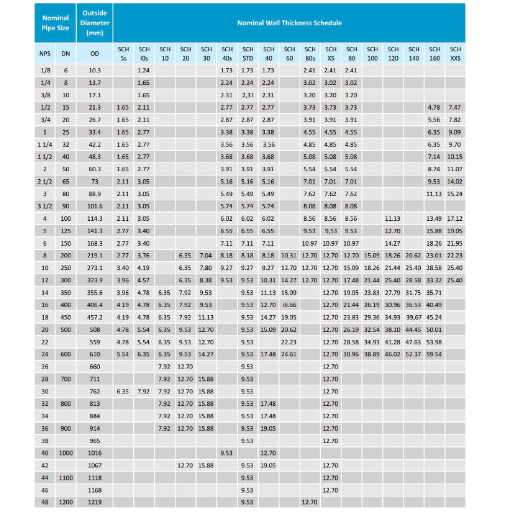
Pipe schedule chart is a tool for finding the thickness of a pipe wall for a given nominal size and schedule number. To read the chart, one has to identify the nominal pipe size first-that is the diameter of the pipe floating in the schedule. Then, locate the schedule number of the pipe for appropriate wall thickness. The actual wall thickness in inches or in millimeters will show for the size and schedule selected from the chart. This information will be used for pipe design according to the particular pressure, temperature, or service requirements.
Understanding Nominal Pipe Size (NPS)
Nominal Pipe Size (NPS) is a standardized system used primarily in the United States to define the diameter of pipes for industrial, construction, and plumbing applications. It is essential to note that “nominal” does not signify the actual outside diameter of the pipe but rather serves as a designation for a range of pipe sizes.
For pipes with a nominal diameter of 12 inches or smaller, the NPS value is indirectly related to the true outside diameter. For example:
- NPS 2 has an actual outside diameter of 2.375 inches (60.3 mm).
- NPS 6 equates to an actual outside diameter of 6.625 inches (168.3 mm).
For sizes over NPS 14, the NPS begins to directly match the outside diameter in inches. For instance, an NPS 16 pipe will have an outside diameter close to 16 inches (406.4 mm).
The variation becomes more pronounced when considering the wall thickness of a pipe. This is specified using the pipe’s “Schedule,” such as Schedule 40 or Schedule 80. The schedule impacts the pipe’s internal diameter and pressure rating:
- A Schedule 40 pipe of NPS 6 has a wall thickness of 0.280 inches (7.11 mm).
- A Schedule 80 pipe of NPS 6 has increased wall thickness at 0.432 inches (10.97 mm), resulting in a smaller internal diameter, which supports higher pressure applications.
NPS is integral when determining the compatibility of pipes with flanges, fittings, or other mechanical connections. By establishing a uniform system, this standard ensures better accuracy and functionality in various industrial applications.
Interpreting Pipe Dimensions and Wall Thickness
On evaluating pipe dimensions, the NPS and Wall-thickness in the form of Schedule are paramount to take into consideration, for they directly affect flow capacity, strength to resist external forces, and applicability to certain pressures or temperature ranges.
The reference to pipe diameter may be concerning any two diameters – an outer diameter or an inner diameter. The outer diameter of the pipe is fixed for a given NPS, whereas the inner diameter changes depending on the wall thickness. For example, a double schedule 40 NPS 6 pipe has an outer diameter of 6.625 inches 168.28 mm but an inner diameter of 6.065 inches 154.07 mm because of its wall thickness of 0.280 inches 7.11 mm. Whereas a schedule 80 NPS 6 pipe having the same 6.625-inch outer diameter has to reduce its inner diameter to 5.761 inches, 146.37 mm in metric due to thicker walls of 0.432 inches 10.97 mm.
The higher the Schedule number, the thicker the walls and, therefore, the pipes are suitable for higher internal pressure. For instance, Schedule 160 pipes or XXS double extra strong pipes are found in industries where strength is needed to paramount, like chemical plants or oil and gas pipelines. These pipes must enter into the realm of being highly difficult and extra strong.
In fact, wall thickness affects pressure rating since the standard ANSI/ASME B31.3, commonly used in the engineering world, describes in detail how to calculate the allowable maximum operating pressure (MAOP) of a pipe with given materials, wall thickness, and temperature.
How to Use a Pipe Wall Thickness Chart
Using a pipe wall thickness chart involves understanding several key aspects to ensure accurate calculations and safe designs. These charts are designed to provide quick reference data for selecting the correct wall thickness based on parameters such as pipe diameter, material properties, pressure, and temperature requirements.
- Determine the Pipe’s Diameter and Material
Start by identifying the nominal diameter of the pipe and the material it is made from. These values are fundamental as material-specific properties, such as tensile strength and temperature limits, significantly affect the wall thickness.
- Identify the Pressure and Temperature Ratings
Find the operational pressure and temperature ranges for the application. Higher pressures or elevated temperatures may require thicker walls to ensure the pipe’s integrity and prevent failure under extreme conditions.
- Consult the Chart
Locate the corresponding nominal diameter on the chart. Check the appropriate column that matches or exceeds the pressure and temperature conditions. Ensure the selected wall thickness aligns with ANSI/ASME B31.3 standards or other applicable regulations.
- Consider Corrosion Allowance
For applications in corrosive environments, an additional allowance for corrosion should be factored in. Most charts include a section for this, allowing adjustments to wall thickness to account for material loss over the pipe’s operational lifespan.
- Validate with Industry Standards
After selecting the appropriate thickness from the chart, cross-reference your findings with prevailing standards, such as ANSI/ASME B36.10M for carbon steel pipes or ANSI/ASME B36.19M for stainless steel pipes. This ensures compliance and safe operation across industries.
By leveraging a pipe wall thickness chart effectively, engineers can ensure precise system designs, maintain regulatory compliance, and improve overall safety and efficiency in industrial applications.
Common Applications of Pipe Schedules
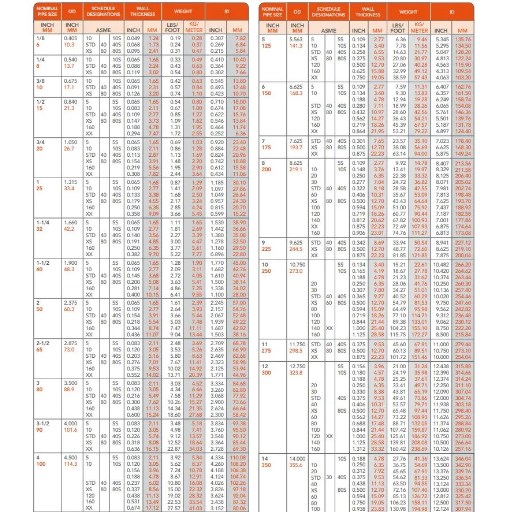
Pipe schedules are commonly used in applications like fluid and gas transport, drainage, irrigation, petrochemical, marine, and industrial systems.
|
Parameter |
Common Applications |
|---|---|
|
Fluids |
Water transport |
|
Gases |
Gas pipelines |
|
Drainage |
Waste systems |
|
Irrigation |
Agriculture |
|
Petrochemical |
Oil & gas systems |
|
Marine |
Ship systems |
|
Industrial |
Machinery |
Applications in the Oil and Gas Industry
Pipe schedules are vital in the oil and gas industry, where safety and long-term durability stand paramount. These industries demand pipelines capable of bearing extreme conditions involving high pressure, higher temperature, and corrosive nature of the transported materials like crude oil, natural gas, and condensates.
Pipes with higher schedules such as Schedule 80 or Schedule 160, are used under high-pressure conditions, such as upstream drilling operations or gas transportation systems. For example, pipelines on offshore platforms with Schedule 40 or above are ensured long-term durability in the challenging marine environment. Stainless steel pipes per ANSI/ASME B36.19M standards offer corrosion resistance and are ideally suited for transporting corrosive substances.
Statistical results are indicative that pipelines in the oil and gas industry transport about seventy percent of all the energy supply worldwide, thereby making the decision for appropriate pipe schedules very important towards keeping the operations uninterrupted on accidents or incidents. Further advances in technology have also made it possible to develop special coatings and monitoring systems to improve pipeline reliability.
Whether downstream refineries, processing plants, or transport systems in the midstream, correct pipe schedule determination will lead to operational efficiency and reduction of the risks of system failure: thus, ensuring safe and cost-effective energy production.
Use in Water Supply and Wastewater Systems
Piping has become instrumental in the efficient distribution of water and proper discharge of wastewater. Water pipelines use durable and corrosion-resistant materials to carry potable water through long distances without subjecting water quality to decline. Among the frequently used materials are PVC, ductile iron, and HDPE pipes, selected mainly for their strength, durability, and resistance against leaks. Most of these systems function in high-pressure heads, and therefore pipe scheduling and material selection should be technically precise to withstand any possible breakdown.
Wastewater systems, meanwhile, and their accompanying infrastructure provide for the collection, conveyance treatment of sewage, and stormwater runoff. In general, large diameter pipes and reinforced concrete or polyethylene pipes are incorporated into the system to withstand chemical corrosion and abrasion from sewage and industrial effluents, respectively. Some of the modern technologies that are applied to reduce interruption and disruption and to ensure smooth operating systems include trenchless pipe installation and sensor-based flow monitoring.
Recent statistics prove that global investments for the modernization of water supply, as well as wastewater infrastructure, are currently experiencing a rise in fast-growing urban centers. It gives examples, as provided by the UN report, whereby an inefficient water system could divert 25-30% of treated water from reaching consumers during distribution. A good piping system fitted with newer leak-detection technologies would certainly curtail such losses, thus enhancing water supply accessibility and sustainability. Therefore, through the use of correct pipe schedules and state-of-the-art pipe materials, water and wastewater systems can serve the growing populations and accommodate their requirements, which further helps in reducing environmental degradation.
Applications in HVAC Systems
HVAC systems ensure comfort and good quality air in a residence, commercial, or industrial setup. Modern-day HVAC systems are utilizing modern piping technologies and novel designs to further optimize performance, energy efficiency, and environmental friendliness. Examples of said systems are variable refrigerant flow systems or VRF systems that have become quite popular for their ability to maintain temperature accurately through controlling refrigerant flow. The studies reveal VRF systems have the potential for saving roughly 30% in energy consumption compared to conventional HVAC systems.
Another major use is hydronics, where water remains the heat transfer medium. Using efficient piping solutions—either PEX pipes or pre-insulated pipes—hydronic conditioning systems can reduce thermal losses and operational costs. Leak detection technologies combined with the best materials then help cut down water and energy wastage within the HVAC systems, hence ensuring a sustainable future. With energy conservation being on top of global considerations, these newly developed technologies in HVAC could hence pave the way in reducing greenhouse gas emissions while improving the efficiency of the system performances.
Selecting the Right Pipe Schedule
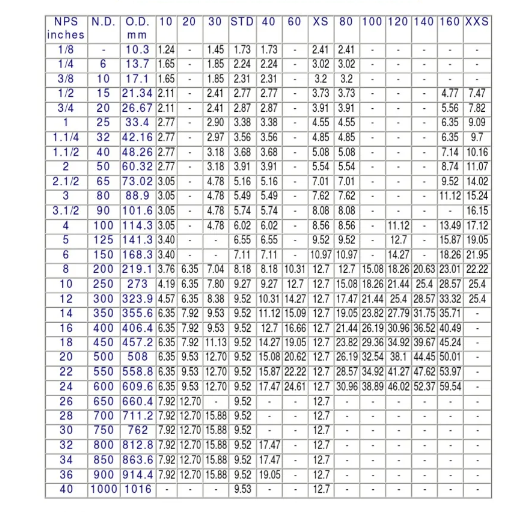
Consider the working temperature and system pressure while having design pressure on one’s mind to select the appropriate pipe schedule. Schedule in respect to pipe means wall thickness; wall thickness in turn will govern the operational stresses of the pipe and, consequently, the flow capacity through the pipe. In systems working at low pressure, lower schedules such as Schedule-40 will do while systems working at high pressure normally require schedules higher than Schedule-80. Corrosion will always be a factor, so one needs to ensure material compatibility with the fluid. The industry standards and guidelines, such as those by ASME or ANSI, should always be considered for safety and performance requirements.
Factors to Consider When Choosing Pipe Sizes
- Flow Rate Requirements
The pipe size must accommodate the required flow rate for the system. This is influenced by the type of fluid being transported and the demand at various points in the system. For example, a pipe carrying water in a residential setting might require a smaller diameter compared to industrial settings which may demand higher flow rates. Use flow rate calculation formulas, such as the Hazen-Williams equation, to determine the optimal size.
- Pressure Rating and System Pressure
Ensure the selected pipe size can tolerate the pressure of the system. A smaller pipe diameter increases velocity and friction losses, which can lead to higher pressure drops. Conversely, larger pipes decrease pressure drop but may not suit high-velocity flow. Always balance diameter with the pressure rating for efficiency.
- Material Type
The material of the pipe significantly affects its sizing. Materials like PVC, steel, or copper have different strength characteristics and internal diameters even if labeled the same nominal size. For example, steel pipes often have thicker walls, slightly reducing internal diameter compared to copper or plastic alternatives.
- Temperature Considerations
High-temperature operations may influence the pipe material and dimensions, as thermal expansion can alter the size and strength of the pipe. Specific materials like stainless steel or PEX tubing are better suited for temperature variations.
- Fluid Characteristics
The viscosity, corrosivity, and temperature of the fluid must be evaluated. High-viscosity fluids require larger pipes to maintain efficient flow, while corrosive fluids may necessitate special coatings or corrosion-resistant materials, indirectly impacting pipe dimensions.
- Budget Constraints
Larger pipes and high-end materials often cost more. Finding a balance between performance needs and cost-effectiveness is key. Consider long-term operational expenses, such as maintenance and energy costs due to pressure drops, when evaluating pipe sizes.
- System Layout
Complex layouts with numerous bends, fittings, and junctions can cause friction losses. These losses must be accounted for during pipe sizing, ensuring sufficient diameter to maintain desired flow rates throughout the system.
- Industry Standards and Codes
Compliance with relevant standards, such as ASME B31.3 for piping design or API codes for specific applications, helps ensure safety, reliability, and regulatory adherence. Standards often provide detailed tables and guidelines for sizing specific to materials and operating conditions.
- Velocity Limits
Both excessively high and low velocities can lead to inefficiencies. High velocity may cause noise, erosion, or system damage, while low velocity may lead to sediment buildup. Ideal velocity ranges vary by application; for instance, water pipes typically aim for 3–8 ft/s while avoiding extremes.
- Future Scalability
Consider potential future needs, such as increased demand or system expansion. Oversizing pipes slightly may reduce headaches and costs down the road, allowing the system to adapt to future changes.
By meticulously evaluating these factors, you can select pipe sizes that optimize performance, minimize costs, and ensure long-term system reliability.
Schedule 40 vs. Schedule 80: Key Differences
Schedule 40 pipes have thinner walls, lower pressure ratings, and are cost-effective, while Schedule 80 pipes have thicker walls, higher pressure ratings, and are more durable but expensive.
|
Parameter |
Schedule 40 |
Schedule 80 |
|---|---|---|
|
Wall |
Thinner |
Thicker |
|
Pressure |
Lower |
Higher |
|
Strength |
Moderate |
Greater |
|
Cost |
Lower |
Higher |
|
Weight |
Lighter |
Heavier |
|
Applications |
Low-pressure |
High-pressure |
|
Ease |
Easier install |
Harder install |
Tips for Selecting Steel vs. Stainless Steel Pipe
Steel pipes are ideal for cost-effective, high-heat, and non-corrosive applications, while stainless steel pipes suit corrosive, aesthetic, and hygiene-critical uses.
|
Parameter |
Steel Pipe |
Stainless Steel Pipe |
|---|---|---|
|
Corrosion |
Avoid corrosive |
Handles corrosive |
|
Cost |
Budget-friendly |
Expensive |
|
Durability |
Moderate |
High |
|
Appearance |
Matte finish |
Shiny finish |
|
Weight |
Heavier |
Lighter |
|
Hygiene |
Not suitable |
Ideal |
|
Temperature |
High heat |
Extreme cold |
|
Applications |
General |
Specialized |
History and Evolution of Pipe Schedule Standards
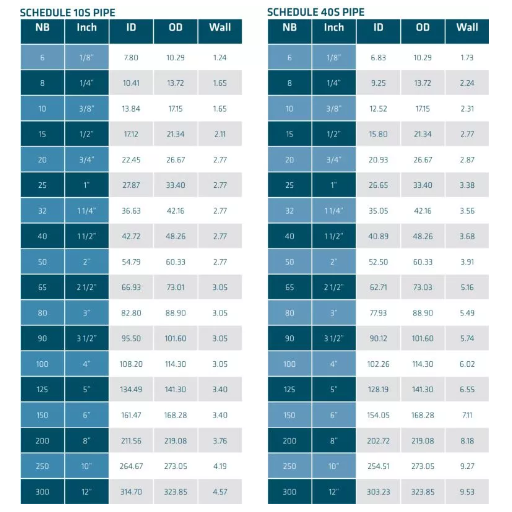
Pipe schedule standards came into being for uniformity with regard to measuring the pipe wall thickness to suit its compatibility for varied industries and applications. These standards were developed in the middle of the 20th century by the American Society of Mechanical Engineers (ASME), with ASME B36.10 and B36.19 introduced for carbon steel and stainless steel pipes, respectively. Hence, these standards replaced the older conflicting sizing methods and gave a systematic way of classifying pipes through their nominal size and wall thickness. The schedule being accepted internationally over the course of time has promoted the compatibility, efficiency, and safety of piping systems. At present, advances in engineering and materials continue to evolve these methods for modern industrial requirements.
Development of Pipe Schedule Designations
The formation of pipe schedule designations has greatly changed over time. Introduced during the 1930s, these designations acted as a categorization system based on wall thickness and purpose. During those days, the standardization was often pursued mainly to remove inconsistencies in pipe manufacturing by bodies such as the American National Standards Institute (ANSI) and the American Society of Mechanical Engineers (ASME). These early standards sought to standardize pipe strength and pressure ratings, thereby assuring that piping systems in different industries could be safely and reliably installed.
Present-day updates into pipe schedules stem from technological advancements, which in turn necessitate enhanced performance in high-pressure systems, extreme temperature atmospheres, or corrosive environments. For example, with novel materials such as high-temperature alloys and corrosion-resistant composites, pipe offerings have become diversified to serve industries like oil & gas, power generation, and chemical processing.
Data suggests that pipe schedules ranging over Schedule 5 (thin-walled) to Schedule 160 (thick-walled) correspondingly increase in withstanding internal pressure. Schedule 40 pipes, the most popular in general-purpose commercial applications, usually offer between 700 and 810 psi pressure handling for a 6-inch size steel pipe at room temperature. Parallel to this, a Schedule 80 pipe of the same nominal size will withstand a pressure in excess of 1,300 psi under identical conditions, thereby emphasizing the importance of wall thickness in pressure retention.
Smart manufacturing technologies, such as 3D printing and precision metallurgy, have promoted even newer methods of pipe customization. In this way, pipe schedule standards are constantly updated to address the ever-changing needs of present industries, thereby encouraging innovation and increasing efficiency even in the most challenging operational environments.
Influence of Industry Standards on Pipe Schedules
Industry standards appear to be of utmost importance to define pipe schedules in the name of consistency, safety, and compatibility across various applications. From my perspective, these standards operate as universal guidelines that give manufacturers and engineers the ability to design systems with specific regulated requirements concerning performance and reliability. They eliminate a great deal of decision making, minimize risk, and provide a platform for innovation-we still must comply with these standards along the way.
Future Trends in Pipe Sizing Standards
With the integration of advanced digital tools and smart technologies, the future of pipe sizing standards is morphing into something new. CFD software is becoming extremely instrumental to engineers who want to have simulations of fluid flow inside pipes under various scenarios with utmost accuracy. This precision allows for the optimization of pipe schedules so as to reduce material wastage, while still maintaining stringent safety standards.
Further, real-time data collection underwent a complete overhaul with its incorporation of IoT sensors that track flow rates, pressure levels, and temperature gradients among others. This information eventually can be used to optimize pipe sizing or to predict maintenance needs. For example, some industries have reported up to 25% reductions in unplanned downtime in recent case studies through IoT-based systems.
The other end trends in the field include AI and machine learning. With predictive modeling capabilities, they examine the impacts of fluid velocity, viscosity, and external temperatures on pipe performance over time. Assisted by the analysis of both historical performance data and environmental variables, AI-based tools guide the recommendation of pipe sizes suitable for different industrial applications.
Finally, sustainability also plays a part in pipe sizing standards. As carbon footprints come under attack, manufacturers have shifted towards experimenting with lightweight materials that offer greater strength, durability, and chemical resistance. Advanced material science with state-of-the-art design codes thus allows industries to think of piping solutions that are eco-friendly without compromising on functionality. Such innovations, in fact, slowly pave the way for being considered the next-generation benchmarks for pipe sizing standards.
Comparative Analysis of Different Pipe Materials
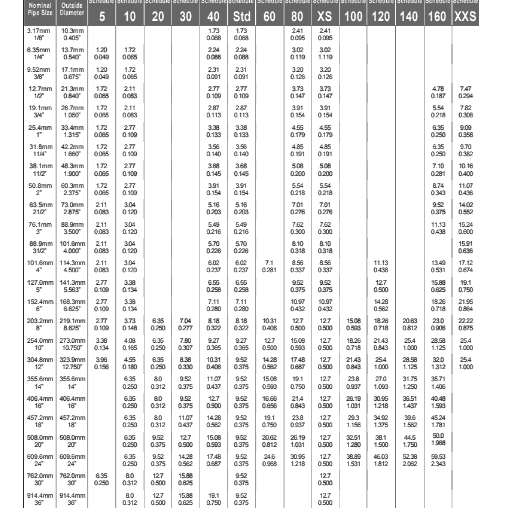
Several factors such as price, durability, and suitability of application must be kept in mind when putting these pipe materials into comparison.
- Steel Pipes: Steel pipes are strong and have high resistance to pressure, so they are good for industrial and heavy-duty applications. The downside is that they rust if not treated and are usually more costly than pipes of other materials.
- PVC Pipes: Among the lightweight types of pipes that are cheaper to buy and used mostly for residential plumbing and drainage systems are PVC pipes. They resist corrosion but may disintegrate if kept in the Sun for long or faced with high temperatures.
- Copper Pipes: Considered a material with higher durability and bacterial resistance, copper pipes are well suited for potable water supply. The downside is that copper pipes are more expensive and prone to theft because of the value of copper.
- PEX Pipes: Flexible and easy to install, PEX piping is becoming increasingly popular in residential plumbing. They are less expensive and do not freeze, but they may not be able to withstand UV exposure well enough for outdoor installation.
Each of these materials has pros and cons that influence the choice depending on the exact use and environmental considerations.
Steel Pipe vs. Stainless Steel Pipe
Steel pipes are cost-effective and strong but prone to rust, while stainless steel pipes are corrosion-resistant, durable, and more expensive.
|
Parameter |
Steel Pipe |
Stainless Steel Pipe |
|---|---|---|
|
Corrosion |
Prone to rust |
Resistant |
|
Cost |
Lower |
Higher |
|
Durability |
Moderate |
High |
|
Appearance |
Matte |
Shiny |
|
Weight |
Heavier |
Lighter |
|
Applications |
General |
Specialized |
|
Temperature |
High heat |
Extreme cold |
|
Composition |
Iron, Carbon |
Chromium, Nickel |
Other Common Materials in Pipe Schedules
When evaluating pipe schedules, several additional materials play a significant role depending on the application, durability requirements, and environmental factors:
- Galvanized Steel: Galvanized steel pipes are coated with a layer of zinc to prevent corrosion. Commonly used in older residential plumbing and outdoor applications, these pipes offer excellent rust resistance. However, they tend to be heavy and may corrode internally over time, reducing water flow. They are best suited for structural uses or non-potable water systems.
- Cast Iron: Used primarily for drainage and wastewater systems, cast iron pipes are known for their strength and exceptional soundproofing capabilities. These pipes effectively reduce the noise of flowing water, making them ideal for multi-story buildings. Despite their durability, cast iron is heavy and susceptible to rust unless coated.
- PVC (Polyvinyl Chloride): Highly versatile and affordable, PVC pipes are widely used in both residential and commercial plumbing. They are resistant to corrosion, lightweight, and easy to install. Standard PVC pipes are suited for cold water systems, while CPVC pipes, with added chlorine resistance, are often used for hot water delivery. PVC is not recommended for high-pressure applications.
- HDPE (High-Density Polyethylene): HDPE pipes have gained attention due to their flexibility, strength, and resistance to chemicals. Commonly used in water supply, sewage systems, and gas pipelines, they are valued for their durability and low maintenance needs. Additionally, HDPE pipes can withstand high-pressure conditions, making them suitable for demanding environments.
- ABS (Acrylonitrile Butadiene Styrene): Known for its shock resistance and strength, ABS pipes are used in drainage, waste, and vent piping systems. Unlike PVC, ABS is more suitable for colder environments but may deform under direct sunlight, making it less ideal for exposed outdoor applications.
- Copper-Nickel Alloys: Copper-nickel pipes are favored in marine and industrial settings due to their excellent corrosion resistance, particularly in saltwater environments. They also exhibit strong thermal stability, making them suitable for heat exchange systems. While costlier than other materials, their superior performance in challenging conditions often justifies the expense.
Each of these materials serves distinct roles in pipe schedules, contributing to a flexible array of solutions tailored to varied industrial, residential, and environmental demands. With advances in manufacturing techniques, these materials continue to evolve, offering enhanced performance and sustainability for diverse piping applications.
Advantages and Disadvantages of Each Material
1. Steel Pipes
Advantages
- Strength and Durability: Steel pipes are renowned for their exceptional strength and ability to withstand high pressures, making them ideal for industrial applications and high-stress environments. They are resistant to deformation under heavy loads.
- Versatile Applications: Used in oil, gas, construction, and water industries due to their ability to transport fluids and gases efficiently.
- Recyclability: Steel is highly recyclable, contributing significantly to sustainable practices within industries.
Disadvantages
- Corrosion Susceptibility: Unless treated or made of stainless steel, steel pipes are prone to rust in moist environments, potentially leading to system failures.
- High Weight: The substantial weight of steel pipes increases handling and transportation costs.
- Thermal Conductivity: Steel has high thermal conductivity, which may require insulation in certain applications to prevent energy loss.
2. PVC (Polyvinyl Chloride) Pipes
Advantages
- Low Cost: PVC pipes are significantly cheaper compared to metal alternatives, making them a cost-effective solution for residential and low-pressure systems.
- Lightweight: Their lightweight characteristic facilitates easy installation and reduces labor costs.
- Corrosion Resistance: PVC is resistant to most chemicals, moisture, and environmental factors, ensuring long-term durability in various settings.
Disadvantages
- Pressure and Temperature Limitations: PVC pipes may not withstand very high temperatures or pressures and are prone to deformation under heat.
- Environmental Concerns: While durable, PVC is made from non-renewable resources and is less eco-friendly due to challenging recycling processes.
- Brittle at Low Temperatures: Under freezing conditions, PVC can become brittle and is more likely to crack.
3. Copper Pipes
Advantages
- High Thermal Conductivity: Copper is excellent for applications requiring efficient heat transfer, such as HVAC systems.
- Corrosion Resistance: Copper pipes resist most forms of corrosion, lending itself to long-lasting plumbing and heating installations.
- Non-Toxic: Ideal for drinking water systems as they do not leach harmful chemicals into the water supply.
Disadvantages
- High Material Cost: The expense of copper makes it a less accessible choice for large-scale projects or cost-sensitive applications.
- Susceptible to Theft: Due to its high market value, copper installations are often targets for theft.
- Potential Reactions in Certain Environments: Copper can react with certain water conditions, leading to issues such as pitting corrosion over time.
4. HDPE (High-Density Polyethylene) Pipes
Advantages
- Flexibility and Impact Resistance: HDPE pipes are highly flexible, making them suitable for seismic-prone areas, and are resistant to physical impacts.
- Chemical Resistance: They can handle a wide range of chemicals, making them ideal for industrial and agricultural applications.
- Longevity: HDPE systems have a life span of up to 50-100 years, ensuring minimal replacement costs over time.
Disadvantages
- Temperature Sensitivity: HDPE pipes may not be the best choice for high-temperature applications as they soften under heat.
- Initial Costs: While affordable in smaller installations, the fusion welding process for HDPE in larger systems can increase initial installation costs.
- UV Degradation: Prolonged UV exposure can degrade HDPE pipes, necessitating protective coatings or coverings in outdoor installations.
Each material brings a distinct set of advantages and challenges to the table, allowing engineers and designers to select the most suitable option based on environmental, economic, and operational requirements.
Reference Sources
-
Auburn University – Pipe and Tube Data
Pipe and Tube Data (PDF)
This document provides detailed pipe and tube data, including dimensions and schedules. -
Washington State University – Sizing Irrigation Mainlines and Fittings
Sizing Irrigation Mainlines and Fittings (PDF)
Includes flow rates and pipe specifications for irrigation systems. -
ASME/ANSI B36.10/19 Standards
ASME/ANSI B36.10/19 Pipe Size Chart (PDF)
A comprehensive chart based on ASME/ANSI standards for pipe sizes and schedules.
Frequently Asked Questions (FAQs)
What is a Pipe Schedule Chart?
A pipe schedule chart is a reference guide that outlines various pipe sizes, wall thicknesses, and other dimensions based on the schedule designation. It helps engineers and designers identify the right pipes for their projects, ensuring they meet specifications such as ASME B36.10M and ASME B36.19.
How to Use a Steel Pipe Schedule?
To use a steel pipe schedule, refer to the pipe schedule chart to determine the nominal pipe size (NPS) based on your required application. The chart will provide information on outside diameter (OD), wall thickness, and weight for different schedules, such as schedule 40 and schedule 80.
What are the Standard Wall Thicknesses for Pipe Sizes?
Standard wall thicknesses for pipe sizes are outlined in the pipe schedule chart, specifying thickness in millimeters or inches depending on the nominal size. Common thicknesses include those for schedule 40 and schedule 80 pipes, which have different pressure resistance capabilities.
What is the Difference Between Schedule 40 and Schedule 80 Pipes?
Schedule 40 and schedule 80 pipes differ in wall thickness, with schedule 80 having thicker pipe walls. This results in higher pressure ratings for schedule 80 pipes, making them suitable for more demanding applications. The pipe weight and dimensions can be found in a corresponding pipe size chart.
How Do I Determine the Nominal Pipe Size?
To determine the nominal pipe size, use the chart to identify the outside diameter and corresponding wall thickness of the pipe you intend to use. The nominal bore is usually a rounded number that simplifies identification and is essential for pipe fittings and connections.
What are the Applications of Seamless Steel Pipes?
Seamless steel pipes are used in various applications, including oil and gas transportation, construction, and plumbing. They are favored for their strength and lack of welded joints, which can be points of failure. Their dimensions can be found in the steel pipe dimensions chart.
What is the Importance of ANSI Pipe Schedules?
ANSI pipe schedules standardize the dimensions and specifications of pipes in the industry, ensuring compatibility across different manufacturers. Using our ANSI pipe schedule helps in selecting the correct pipe size and wall thickness for specific engineering and design applications.
How Can I Use a Pipe Weight Chart?
A pipe weight chart provides information on the weight of various pipe sizes and schedules. This is crucial for understanding load requirements and ensuring structural integrity in applications. The chart includes weight and schedule designations for both standard and specialty pipes.
What are the Common Steel Pipe Dimensions?
Common steel pipe dimensions include the outside diameter, inside diameter, wall thickness, and nominal size. These dimensions are critical for ensuring proper fit and function in piping systems and can be easily referenced in a comprehensive pipe size chart.



